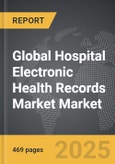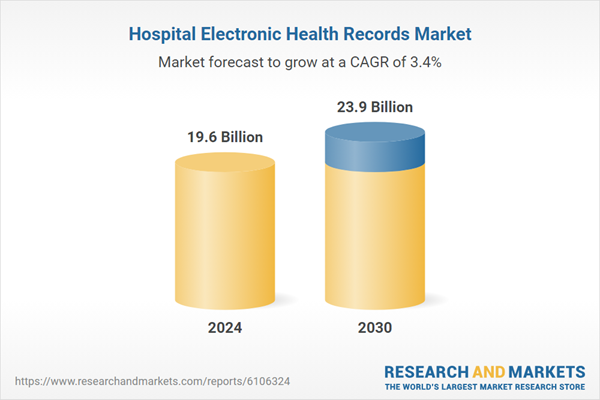Global Hospital Electronic Health Records Market - Key Trends & Drivers Summarized
How Are Electronic Health Records Redefining Hospital Workflows and Clinical Efficiency?
Electronic health records (EHRs) have become foundational to modern hospital operations, fundamentally reshaping workflows, clinical decision-making, and administrative coordination. As hospitals transition away from paper-based documentation, EHR systems offer a unified digital interface that captures, stores, and manages a patient's entire medical journey in real time. Clinicians benefit from immediate access to lab results, imaging reports, medication history, and prior diagnoses, enabling faster and more accurate decision-making during consultations and emergencies. This instant access reduces duplication of diagnostic tests, minimizes errors in medication prescribing, and improves continuity of care, especially for patients who consult multiple specialists. EHRs also support structured data entry, ensuring that clinical notes, vital signs, and other records are standardized and easier to interpret across departments. With integrated clinical alerts and reminders, EHRs help prevent adverse drug interactions and ensure adherence to best-practice treatment protocols. From an operational standpoint, EHRs facilitate better scheduling, reduce paperwork, and streamline billing by linking directly with hospital revenue cycle systems. Hospitals are increasingly embedding artificial intelligence and predictive analytics into EHR platforms to flag high-risk patients, suggest treatment pathways, and optimize resource allocation. These systems also enhance audit readiness and legal compliance by maintaining accurate records of all patient interactions. As hospitals face rising patient volumes and staff shortages, EHRs play a crucial role in helping healthcare teams manage caseloads more effectively while maintaining high standards of patient care. The shift toward digital recordkeeping is not only about convenience but also about creating a scalable infrastructure for better clinical outcomes and hospital performance.Why Is Interoperability Emerging as a Central Theme in EHR System Development?
As hospital networks grow larger and care becomes more collaborative, the demand for interoperable electronic health record systems has become increasingly urgent. Interoperability refers to the ability of EHR platforms to share and interpret data across various healthcare providers, regardless of software vendor or geographic location. With patients often receiving care from multiple facilities and specialists, the ability to transfer medical information seamlessly is essential for continuity and quality of care. Hospitals are now prioritizing systems that can integrate with regional health information exchanges, external laboratories, pharmacies, and even wearable health devices. By supporting standardized data formats and protocols, modern EHR platforms make it easier for healthcare teams to view a complete picture of a patient's health, avoiding the pitfalls of fragmented care. Interoperability also supports public health goals by enabling the aggregation of data for disease surveillance, vaccination tracking, and population health analytics. Hospitals participating in research or clinical trials are finding interoperable systems invaluable for recruiting participants, collecting uniform data, and complying with ethical oversight. From a regulatory perspective, governments in many countries are enforcing data-sharing requirements to improve transparency and empower patients with more control over their records. Healthcare providers are responding by implementing APIs and FHIR-based frameworks that allow secure, permission-based access to health data. The ultimate aim is to create an ecosystem where medical records are no longer siloed but follow the patient wherever they receive care. Hospitals that invest in interoperable EHRs not only improve clinical coordination but also position themselves as future-ready institutions in a rapidly digitizing healthcare landscape.How Are User Experience and Workflow Design Impacting EHR Adoption in Hospitals?
The usability of electronic health record systems is emerging as a make-or-break factor in their successful implementation within hospitals. While the technical capabilities of EHRs are well recognized, poor user experience can lead to physician burnout, workflow inefficiencies, and even patient safety issues. Doctors, nurses, and administrative staff all interact with EHRs differently, and systems that do not align with real-world clinical workflows often result in wasted time, documentation fatigue, and low staff morale. Hospitals are now working closely with vendors to co-design user interfaces that are intuitive, responsive, and aligned with the unique demands of various medical specialties. Voice-enabled data entry, drag-and-drop interfaces, and personalized dashboards are being introduced to simplify interactions and reduce the cognitive load on healthcare workers. Customization is also becoming a core focus, with systems allowing users to configure templates, shortcuts, and alerts based on their preferences and roles. EHRs that offer mobile and tablet compatibility are especially valuable in large hospitals where clinicians are constantly moving between wards, operating rooms, and outpatient departments. Training and support services are being reimagined to include simulation-based learning, on-demand tutorials, and peer coaching to help staff navigate these complex systems more confidently. Some hospitals are even establishing “EHR champion” teams within departments to troubleshoot issues and gather user feedback for continuous improvement. Data visualization tools embedded in EHRs are helping clinicians interpret trends quickly, such as vital sign changes or lab result patterns, without sifting through multiple screens. The growing emphasis on human-centered design is making EHRs not just a repository of patient information, but a strategic tool that enhances decision-making, teamwork, and overall care quality.What Factors Are Driving the Continued Growth of the Hospital EHR Market Worldwide?
The growth in the hospital electronic health records market is driven by several key factors that reflect both the evolution of healthcare systems and the increasing demand for integrated, data-driven care delivery. One of the most significant drivers is the global shift toward digitization in healthcare, supported by government mandates, incentive programs, and policy frameworks that promote the adoption of EHR systems. As hospitals aim to improve quality of care while reducing costs, EHRs are being embraced as essential tools for streamlining operations and enhancing clinical documentation. Another major driver is the need for real-time data access and decision support in high-acuity environments such as emergency rooms and intensive care units, where timely information can have life-saving implications. The growing burden of chronic diseases is prompting hospitals to adopt EHRs with care coordination features that support long-term patient management, reduce readmissions, and enable better follow-up care. Rising patient expectations for digital engagement, including access to their medical history, test results, and appointment schedules, are also pushing hospitals to upgrade their systems with patient portal functionalities. In developing markets, international funding and public-private partnerships are helping to bridge the digital gap by financing EHR implementation in public hospitals. Additionally, the outbreak of global health emergencies has highlighted the importance of agile and scalable data systems that can support rapid surveillance and response. The increasing availability of cloud-based EHR platforms is lowering the barrier to entry for small and mid-sized hospitals, making digital transformation more accessible. The convergence of health IT with artificial intelligence, big data, and machine learning is further expanding the value proposition of EHRs, ensuring their continued adoption and growth across diverse healthcare settings.Report Scope
The report analyzes the Hospital Electronic Health Records market, presented in terms of market value (US$). The analysis covers the key segments and geographic regions outlined below:- Segments: Type (Interoperable EMRs, Speech enabled EMRs, Traditional EMRs, Other Types); Component (Hardware Component, Software Component, Services Component); Deployment (Cloud-based Deployment, On-Premise Deployment); Application (Cardiology Application, Neurology Application, Oncology Application, Radiology Application, Other Applications).
- Geographic Regions/Countries: World; United States; Canada; Japan; China; Europe (France; Germany; Italy; United Kingdom; Spain; Russia; and Rest of Europe); Asia-Pacific (Australia; India; South Korea; and Rest of Asia-Pacific); Latin America (Argentina; Brazil; Mexico; and Rest of Latin America); Middle East (Iran; Israel; Saudi Arabia; United Arab Emirates; and Rest of Middle East); and Africa.
Key Insights:
- Market Growth: Understand the significant growth trajectory of the Interoperable EMRs segment, which is expected to reach US$10.5 Billion by 2030 with a CAGR of a 3.6%. The Speech enabled EMRs segment is also set to grow at 3.9% CAGR over the analysis period.
- Regional Analysis: Gain insights into the U.S. market, valued at $5.3 Billion in 2024, and China, forecasted to grow at an impressive 6.3% CAGR to reach $4.7 Billion by 2030. Discover growth trends in other key regions, including Japan, Canada, Germany, and the Asia-Pacific.
Why You Should Buy This Report:
- Detailed Market Analysis: Access a thorough analysis of the Global Hospital Electronic Health Records Market, covering all major geographic regions and market segments.
- Competitive Insights: Get an overview of the competitive landscape, including the market presence of major players across different geographies.
- Future Trends and Drivers: Understand the key trends and drivers shaping the future of the Global Hospital Electronic Health Records Market.
- Actionable Insights: Benefit from actionable insights that can help you identify new revenue opportunities and make strategic business decisions.
Key Questions Answered:
- How is the Global Hospital Electronic Health Records Market expected to evolve by 2030?
- What are the main drivers and restraints affecting the market?
- Which market segments will grow the most over the forecast period?
- How will market shares for different regions and segments change by 2030?
- Who are the leading players in the market, and what are their prospects?
Report Features:
- Comprehensive Market Data: Independent analysis of annual sales and market forecasts in US$ Million from 2024 to 2030.
- In-Depth Regional Analysis: Detailed insights into key markets, including the U.S., China, Japan, Canada, Europe, Asia-Pacific, Latin America, Middle East, and Africa.
- Company Profiles: Coverage of players such as Atento, Authenticx, Carenet Health, CloudTalk, Concentrix Dash Corporation and more.
- Complimentary Updates: Receive free report updates for one year to keep you informed of the latest market developments.
Some of the 34 companies featured in this Hospital Electronic Health Records market report include:
- AdvancedMD
- Allscripts (Veradigm)
- Cerner (Oracle Health)
- CompuGroup Medical
- CPSI (Evident)
- CureMD Healthcare
- eClinicalWorks
- Epic Systems
- GE Healthcare
- Greenway Health
- McKesson Corporation
- Meditech
- Meditab Software
- NextGen Healthcare
- Netsmart Technologies
- Orion Health
- QHR Technologies
- TruBridge (Meditech spun-off)
- Veradigm (Allscripts spin-off)
- Vista (formerly Vitera)
- WellSky
This edition integrates the latest global trade and economic shifts into comprehensive market analysis. Key updates include:
- Tariff and Trade Impact: Insights into global tariff negotiations across 180+ countries, with analysis of supply chain turbulence, sourcing disruptions, and geographic realignment. Special focus on 2025 as a pivotal year for trade tensions, including updated perspectives on the Trump-era tariffs.
- Adjusted Forecasts and Analytics: Revised global and regional market forecasts through 2030, incorporating tariff effects, economic uncertainty, and structural changes in globalization. Includes historical analysis from 2015 to 2023.
- Strategic Market Dynamics: Evaluation of revised market prospects, regional outlooks, and key economic indicators such as population and urbanization trends.
- Innovation & Technology Trends: Latest developments in product and process innovation, emerging technologies, and key industry drivers shaping the competitive landscape.
- Competitive Intelligence: Updated global market share estimates for 2025, competitive positioning of major players (Strong/Active/Niche/Trivial), and refined focus on leading global brands and core players.
- Expert Insight & Commentary: Strategic analysis from economists, trade experts, and domain specialists to contextualize market shifts and identify emerging opportunities.
Table of Contents
Companies Mentioned (Partial List)
A selection of companies mentioned in this report includes, but is not limited to:
- AdvancedMD
- Allscripts (Veradigm)
- Cerner (Oracle Health)
- CompuGroup Medical
- CPSI (Evident)
- CureMD Healthcare
- eClinicalWorks
- Epic Systems
- GE Healthcare
- Greenway Health
- McKesson Corporation
- Meditech
- Meditab Software
- NextGen Healthcare
- Netsmart Technologies
- Orion Health
- QHR Technologies
- TruBridge (Meditech spun-off)
- Veradigm (Allscripts spin-off)
- Vista (formerly Vitera)
- WellSky
Table Information
| Report Attribute | Details |
|---|---|
| No. of Pages | 469 |
| Published | December 2025 |
| Forecast Period | 2024 - 2030 |
| Estimated Market Value ( USD | $ 19.6 Billion |
| Forecasted Market Value ( USD | $ 23.9 Billion |
| Compound Annual Growth Rate | 3.4% |
| Regions Covered | Global |









